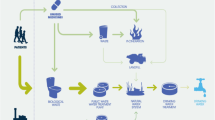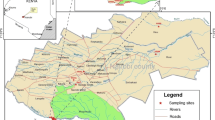Abstract
The detection of antibiotics in water systems has instigated great environmental concern due to the toxicological effects associated with these compounds. Their discharge into the environment results from the ubiquity of use in medical, veterinary, and agricultural practices. Some of the effects of antibiotics include development of antibiotic-resistant bacteria, making it difficult to treat diseases, variation in natural microbial communities, and enzyme activities. In this study, the first comprehensive survey of some frequently used antibiotics namely ampicillin (AMP), amoxicillin (AMX), sulfamethoxazole (SMX), chloramphenicol (CAP), and ciprofloxacin (CPF) within Lake Victoria Basin of Kenya is presented. Sludge and wastewater samples were collected from wastewater treatment plants (WWTPs) and hospital lagoons within the study area. Samples were extracted and cleaned by solid-phase extraction, and analysis was carried out using high-performance liquid chromatography (HPLC). All wastewater samples and sludge collected contained quantifiable levels of the selected antibiotics. The highest concentrations were recorded for AMP with WWTPs and hospitals having 0.36 ± 0.04 and 0.79 ± 0.07 μg/L, respectively. In sludge samples, SMX recorded the highest concentrations of 276 ± 12 ng/g. The high levels in sludge indicate the preferential partition of antibiotics onto solid phase, posing great danger to consumers of crops grown in biosolid-amended soils. The daily discharge loads of antibiotics from nine WWTPs ranged between 80.75 and 3044.9 mg day−1 with a total discharge of 6395.85 mg day−1, signifying a high potential of water resource pollution within the region. This report will aid in the assessment of the risks posed by antibiotics released into the environment.

Similar content being viewed by others
References
Bottoni, P., & Caroli, S. (2015). Detection and quantification of residues and metabolites of medicinal products in environmental compartments, food commodities and workplaces. A review. J. Pharmac and Biomed. Anal., 106, 3–24.
Chagas, T. P. G., Seki, L. M., Cury, J. C., Oliveira, J. A. L., Dávila, A. M. R., Silva, D. M., & Asensi, M. D. (2011). Multiresistance, beta-lactamase-encoding genes and bacterial diversity in hospital wastewater in Rio de Janeiro Brazil. Journal of Applied Microbiology, 111, 572–581.
Chirikona, F., Filipovic, M., Ooko, S., & Orata, F. (2015). Perfluoroalkyl acids in selected wastewater treatment plants and their discharge load within the Lake Victoria basin in Kenya. Environ. Monit. and Ass., 187(5), 238.
Cizmas, L., Sharma, V. K., Gray, C. M., & Mcdonald, T. J. (2015). Pharmaceuticals and personal care products in waters : occurrence, toxicity, and risk. Environmental Chemistry Letters. doi:10.1007/s10311-015-0524-4.
Clara, M., Strenn, B., Gans, O., Martinez, E., Kreuzinger, N., & Kroiss, H. (2005). Removal of selected pharmaceuticals, fragrances and endocrine disrupting compounds in a membrane bioreactor and conventional WWTPs. Water Research, 39, 4797–4807.
Dinsdale, R. M., Kasprzyk-Hordern, B., & Guwy, A. J. (2009). The removal of pharmaceuticals, personal care products, endocrine disruptors and illicit drugs during wastewater treatment and its impact on the quality of receiving water. Water Research, 43, 363.
Gao, P., Mao, D., Luo, Y., Wang, L., Xu, B., & Xu, L. (2012). Occurrence of sulphonamide and tetracycline-resistant bacteria and resistance genes in aquaculture environment. Water Research, 46, 2355–2364.
Giger, W., Alder, A. C., Golet, E. M., Kohler, H. P. E., McArdell, C. S., Molnar, E., et al. (2003). Occurrence and fate of antibiotics as trace contaminants in wastewaters, sewage sludges, and surface waters. CHIMIA Int. J. Chem., 57(9), 485–491.
Godoy, A. A., Kummrow, F., & Pamplin, P. A. (2015). Occurrence, ecotoxicological effects and risk assessment of antihypertensive pharmaceutical residues in the aquatic environment—a review. Chemosphere, 138, 281–291.
Gracia-Lor, E., Sancho, J. V., Serrano, R., & Hernández, F. (2012). Occurrence and removal of pharmaceuticals in wastewater treatment plants at the Spanish Mediterranean area of Valencia. Chemosphere, 87(5), 453–462.
Gurke, R., Rößler, M., Marx, C., Diamond, S., Schubert, S., Oertel, R., & Fauler, J. (2015). Occurrence and removal of frequently prescribed pharmaceuticals and corresponding metabolites in wastewater of a sewage treatment plant. Sci. Tot. Environ., 532, 762–770.
He, K., Soares, A. D., Adejumo, H., McDiarmid, M., Squibb, K., & Blaney, L. (2014). Detection of a wide variety of human and veterinary fluoroquinolone antibiotics in municipal wastewater and wastewater-impacted surface water. J. of Pharmac and Biomedl Analysis, 106, 136–143.
Heberer, T., Reddersen, K., & Mechlinski, A. (2002). From municipal sewage to drinking water: fate and removal of pharmaceutical residues in the aquatic environment in urban areas. Water Science and Technology, 46, 81–88.
Helba, L., Kantor, A., Petrova, J., & Kacaniova, M. (2016). Detection of ampicillin, its sodium salt and alkaline hydrolysis products by MALDI-TOF mass spectrometry. Scientific Papers: Animal Science and Biotechnologies, 49(1), 83–87.
Jelic, A., Gros, M., Ginebreda, A., Cespedes-Sánchez, R., Ventura, F., Petrovic, M., & Barceló, D. (2011). Occurrence, partition and removal of pharmaceuticals in sewage water and sludge during wastewater treatment. Water Research, 45, 1165–1176.
Kihampa, C. (2014). β-lactams and Fluoroquinolone Antibiotics in influents and effluents of Wastewater treatment plants, Dar es Salaam, Tanzania. Research Journal of Chemical Sciences, 4(6), 31–36.
K’oreje, K. O., Demeestere, K., Wispelaere, P., Vergeynst, L., Dewulf, J., & Langenhove, H. (2012). From multi-residue screening to target analysis of pharmaceuticals in water: development of a new approach based on magnetic sector mass spectrometry and application in the Nairobi River basin Kenya. The Science of the Total Environment, 437, 153–164.
K’oreje, K. O., Vergeynst, L., Ombaka, D., De Wispelaer, P., Okoth, M., Van Langenhove, H., & Demeestere, K. (2016). Occurrence patterns of pharmaceutical residues in wastewater, surface water and groundwater of Nairobi and Kisumu city, Kenya. Chemosphere, 149, 238–244.
Lemus, J. Á., Blanco, G., Grande, J., Arroyo, B., García-Montijano, M., & Martínez, F. (2008). Antibiotics threaten wildlife: circulating quinolone residues and disease in avian scavengers. PloS One, 3(1).
Li, W. C. (2014). Occurrence, sources, and fate of pharmaceuticals in aquatic environment and soil. A review. Environ. Poll., 187, 193–201.
Li, B., & Zhang, T. (2011). Mass flows and removal of antibiotics in two municipal wastewater treatment plants. Chemosphere, 83(9), 1284–1289.
Liang, X., Chen, B., Nie, X., Shi, Z., Huang, X., & Li, X. (2013). The distribution and partitioning of common antibiotics in water and sediment of the Pearl River Estuary, South China. Chemosphere, 92(11), 1410–1416.
Lisouza, F. A., Owuor, P. O., & Lalah, J. O. (2011). Variation in indoor levels of polycyclic aromatic hydrocarbons from burning various biomass types in the traditional grass-roofed households in Western Kenya. J. Environ. Pol, 159, 1810–1815.
Liu, F., Ying, G. G., Tao, R., Zhao, J. L., Yang, J. F., & Zhao, L. F. (2009). Effects of six selected antibiotics on plant growth and soil microbial and enzymatic activities. Environmental Pollution, 157, 1636–1642.
Matozzo, V. (2014). Effects of pharmaceuticals on immune parameters of aquatic invertebrates; A review. Invertebrate Survival Journal, 11, 163–173.
Nakata, H., Kannan, K., Jones, P. D., & Giesy, J. P. (2005). Determination of fluoroquinolone antibiotics in wastewater effluents by liquid chromatography–mass spectrometry and fluorescence detection. Chemosphere, 58(6), 759–766.
Nguyen, C., Giang, D., Sebesvari, Z., Renaud, F., & Rosendahl, I. (2015). Occurrence and dissipation of the antibiotics trimethoprim, and enrofloxacin in the Mekong Delta. Vietnam, 1–24. doi:10.1371/journal.pone.0131855.
Orata, F., Quinete, N., & Wilken, R. (2009). Long chain perfluorinated alkyl acids derivatisation and identification in biota and abiota matrices using gas chromatography. Bul Environ Contam and Toxicol, 83, 630–635.
Park, H., & Choung, Y. (2007). Degradation of antibiotics (tetracycline, sulfathiazole, ampicillin) using enzymes of glutathion s-transferase. Int. J. Human and Ecolog. Risk assess., 13(5), 1147–1155.
Radjenović, J., Petrović, M., Barceló, D. (2009). Fate and distribution of pharmaceuticals in wastewater and sewage sludge of the conventional activated sludge (CAS) and advanced membrane bioreactor (MBR) treatment. Water Research, 43(3), 831–841.
Straub, J. O. (2015). Aquatic environmental risk assessment for human use of the old antibiotic sulfamethoxazole in Europe. Environmental Toxicology and Chemistry, 9999(9999), n/a–n/a. doi:10.1002/etc.2945.
Ternes, T., Bonerz, M., & Schmidt, T. (2001). Determination of neutral pharmaceuticals in wastewater and rivers by liquid chromatography-electrospray tandem mass spectrometry. Journal of Chromatography. A, 938, 175–185.
Tsiaka, P., Tsarpali, V., Ntaikou, I., et al. (2013). Ecotoxicology, 22, 1208. doi:10.1007/s10646-013-1108-3.
van der Ven, K., van Dongen, W., Maes, B. U. W., Esmans, E. L., Blust, R., de Coen, W. M. (2004). Determination of diazepam in aquatic samples by capillary liquid chromatography electrospray tandem mass spectrometry. Chemosphere, 57(8), 967–73.
Werimo, K., Bergwerff, A., & Seinen, W. (2009). Residue levels of organochlorines and organophosphates in water, fish and sediments from Lake Victoria-Kenyan portion. J. Aquatic Ecosys Health & Manag, 12(3), 337–341.
Yang, X., Flowers, R. C., Weinberg, H. S., & Singer, P. C. (2011). Occurrence and removal of pharmaceuticals and personal care products (PPCPs) in an advanced wastewater reclamation plant. Water Research, 45(16), 5218–5228.
Acknowledgments
The authors are grateful for support from Alexander Von Humboldt research grant (3.4-IP-1119366/s-700611-5044-001). We also acknowledge Chuka University for availing HPLC instrument for analysis. We thank Agnes Muyale for assistance in analysis.
Author information
Authors and Affiliations
Corresponding author
Rights and permissions
About this article
Cite this article
Kimosop, S.J., Getenga, Z.M., Orata, F. et al. Residue levels and discharge loads of antibiotics in wastewater treatment plants (WWTPs), hospital lagoons, and rivers within Lake Victoria Basin, Kenya. Environ Monit Assess 188, 532 (2016). https://doi.org/10.1007/s10661-016-5534-6
Received:
Accepted:
Published:
DOI: https://doi.org/10.1007/s10661-016-5534-6




